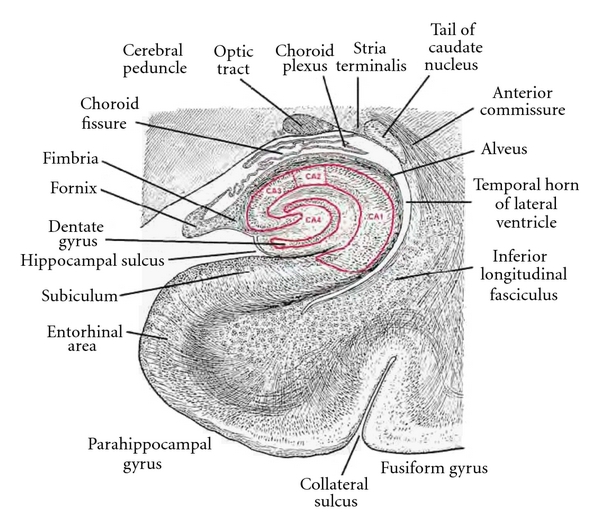|
Amygdalohippocampectomy
Amygdalohippocampectomy is a surgical procedure for the treatment of epilepsy. It consists of the removal of the hippocampus, which has a role in memory, spatial awareness, and navigation, and the amygdalae, which have a role in the processing and memory of emotional reactions, both structures forming part of the limbic system of the brain. Amygdalohippocampectomy is used only when all other treatment options have failed to resolve the epilepsy. It is also used to cure severe aggression, and anxiety usually as a last resort treatment. It is an effective treatment for most patients. However, possible adverse side effects include impaired memory, dangerous risktaking behaviours, and defects in visual perception. __TOC__ Procedure The amygdalohippocampectomy is indicated when the focal point of the seizures can be anatomically localized to the hippocampus and amygdala. Normally, to be considered for this procedure, one must either have failed all first-line treatments for epileps ... [...More Info...] [...Related Items...] OR: [Wikipedia] [Google] [Baidu] |
Amygdalae
The amygdala (; : amygdalae or amygdalas; also '; Latin from Greek, , ', 'almond', 'tonsil') is a paired nuclear complex present in the cerebral hemispheres of vertebrates. It is considered part of the limbic system. In primates, it is located medially within the temporal lobes. It consists of many nuclei, each made up of further subnuclei. The subdivision most commonly made is into the basolateral, central, cortical, and medial nuclei together with the intercalated cell clusters. The amygdala has a primary role in the processing of memory, decision-making, and emotional responses (including fear, anxiety, and aggression). The amygdala was first identified and named by Karl Friedrich Burdach in 1822. Structure Thirteen nuclei have been identified, each with their own subdivisions and distinct connections to the rest of the brain. The chief nuclei are the basolateral complex, the central nucleus, the cortical nucleus, the medial nucleus, and the intercalated cel ... [...More Info...] [...Related Items...] OR: [Wikipedia] [Google] [Baidu] |
Hippocampus
The hippocampus (: hippocampi; via Latin from Ancient Greek, Greek , 'seahorse'), also hippocampus proper, is a major component of the brain of humans and many other vertebrates. In the human brain the hippocampus, the dentate gyrus, and the subiculum are components of the hippocampal formation located in the limbic system. The hippocampus plays important roles in the Memory consolidation, consolidation of information from short-term memory to long-term memory, and in spatial memory that enables Navigation#Navigation in spatial cognition, navigation. In humans, and other primates the hippocampus is located in the archicortex, one of the three regions of allocortex, in each cerebral hemisphere, hemisphere with direct neural projections to, and reciprocal indirect projections from the neocortex. The hippocampus, as the medial pallium, is a structure found in all vertebrates. In Alzheimer's disease (and other forms of dementia), the hippocampus is one of the first regions of th ... [...More Info...] [...Related Items...] OR: [Wikipedia] [Google] [Baidu] |
Neurology
Neurology (from , "string, nerve" and the suffix wikt:-logia, -logia, "study of") is the branch of specialty (medicine) , medicine dealing with the diagnosis and treatment of all categories of conditions and disease involving the nervous system, which comprises the Human brain, brain, the spinal cord and the peripheral nervous system , peripheral nerves. Neurological practice relies heavily on the field of neuroscience, the scientific study of the nervous system, using various techniques of neurotherapy. IEEE Brain (2019). "Neurotherapy: Treating Disorders by Retraining the Brain". ''The Future Neural Therapeutics White Paper''. Retrieved 23.01.2025 from: https://brain.ieee.org/topics/neurotherapy-treating-disorders-by-retraining-the-brain/#:~:text=Neurotherapy%20trains%20a%20patient's%20brain,wave%20activity%20through%20positive%20reinforcement International Neuromodulation Society, Retrieved 23 January 2025 from: https://www.neuromodulation.com/ Val Danilov I (2023). "The O ... [...More Info...] [...Related Items...] OR: [Wikipedia] [Google] [Baidu] |
Epilepsy
Epilepsy is a group of Non-communicable disease, non-communicable Neurological disorder, neurological disorders characterized by a tendency for recurrent, unprovoked Seizure, seizures. A seizure is a sudden burst of abnormal electrical activity in the brain that can cause a variety of symptoms, ranging from brief lapses of awareness or muscle jerks to prolonged convulsions. These episodes can result in physical injuries, either directly, such as broken bones, or through causing accidents. The diagnosis of epilepsy typically requires at least two unprovoked seizures occurring more than 24 hours apart. In some cases, however, it may be diagnosed after a single unprovoked seizure if clinical evidence suggests a high risk of recurrence. Isolated seizures that occur without recurrence risk or are provoked by identifiable causes are not considered indicative of epilepsy. The underlying cause is often unknown, but epilepsy can result from brain injury, stroke, infections, Brain tumor, ... [...More Info...] [...Related Items...] OR: [Wikipedia] [Google] [Baidu] |
Hippocampus
The hippocampus (: hippocampi; via Latin from Ancient Greek, Greek , 'seahorse'), also hippocampus proper, is a major component of the brain of humans and many other vertebrates. In the human brain the hippocampus, the dentate gyrus, and the subiculum are components of the hippocampal formation located in the limbic system. The hippocampus plays important roles in the Memory consolidation, consolidation of information from short-term memory to long-term memory, and in spatial memory that enables Navigation#Navigation in spatial cognition, navigation. In humans, and other primates the hippocampus is located in the archicortex, one of the three regions of allocortex, in each cerebral hemisphere, hemisphere with direct neural projections to, and reciprocal indirect projections from the neocortex. The hippocampus, as the medial pallium, is a structure found in all vertebrates. In Alzheimer's disease (and other forms of dementia), the hippocampus is one of the first regions of th ... [...More Info...] [...Related Items...] OR: [Wikipedia] [Google] [Baidu] |
Limbic System
The limbic system, also known as the paleomammalian cortex, is a set of brain structures located on both sides of the thalamus, immediately beneath the medial temporal lobe of the cerebrum primarily in the forebrain.Schacter, Daniel L. 2012. ''Psychology''.sec. 3.20 Its various components support a variety of functions including emotion, behavior, long-term memory, and olfaction. The limbic system is involved in lower order emotional processing of input from sensory systems and consists of the amygdala, mammillary bodies, stria medullaris, central gray and dorsal and ventral nuclei of Gudden. This processed information is often relayed to a collection of structures from the telencephalon, diencephalon, and mesencephalon, including the prefrontal cortex, cingulate gyrus, limbic thalamus, hippocampus including the parahippocampal gyrus and subiculum, nucleus accumbens (limbic striatum), anterior hypothalamus, ventral tegmental area, midbrain raphe nuclei, habenular commi ... [...More Info...] [...Related Items...] OR: [Wikipedia] [Google] [Baidu] |
Brain
The brain is an organ (biology), organ that serves as the center of the nervous system in all vertebrate and most invertebrate animals. It consists of nervous tissue and is typically located in the head (cephalization), usually near organs for special senses such as visual perception, vision, hearing, and olfaction. Being the most specialized organ, it is responsible for receiving information from the sensory nervous system, processing that information (thought, cognition, and intelligence) and the coordination of motor control (muscle activity and endocrine system). While invertebrate brains arise from paired segmental ganglia (each of which is only responsible for the respective segmentation (biology), body segment) of the ventral nerve cord, vertebrate brains develop axially from the midline dorsal nerve cord as a brain vesicle, vesicular enlargement at the rostral (anatomical term), rostral end of the neural tube, with centralized control over all body segments. All vertebr ... [...More Info...] [...Related Items...] OR: [Wikipedia] [Google] [Baidu] |
Electrophysiology
Electrophysiology (from [see the Electron#Etymology, etymology of "electron"]; ; and ) is the branch of physiology that studies the electrical properties of biological cell (biology), cells and tissues. It involves measurements of voltage changes or electric current or manipulations on a wide variety of scales from single ion channel proteins to whole organs like the heart. In neuroscience, it includes measurements of the electrical activity of neurons, and, in particular, action potential activity. Recordings of large-scale electric signals from the nervous system, such as electroencephalography, may also be referred to as electrophysiological recordings. They are useful for electrodiagnostic medicine, electrodiagnosis and monitoring (medicine), monitoring. Definition and scope Classical electrophysiological techniques Principle and mechanisms Electrophysiology is the branch of physiology that pertains broadly to the flow of ions (ion current) in biological tissues and, in p ... [...More Info...] [...Related Items...] OR: [Wikipedia] [Google] [Baidu] |
Neuropathy
Peripheral neuropathy, often shortened to neuropathy, refers to damage or disease affecting the nerves. Damage to nerves may impair sensation, movement, gland function, and/or organ function depending on which nerve fibers are affected. Neuropathies affecting motor, sensory, or autonomic nerve fibers result in different symptoms. More than one type of fiber may be affected simultaneously. Peripheral neuropathy may be acute (with sudden onset, rapid progress) or chronic (symptoms begin subtly and progress slowly), and may be reversible or permanent. Common causes include systemic diseases (such as diabetes or leprosy), hyperglycemia-induced glycation, vitamin deficiency, medication (e.g., chemotherapy, or commonly prescribed antibiotics including metronidazole and the fluoroquinolone class of antibiotics (such as ciprofloxacin, levofloxacin, moxifloxacin)), traumatic injury, ischemia, radiation therapy, excessive alcohol consumption, immune system disease, celiac dis ... [...More Info...] [...Related Items...] OR: [Wikipedia] [Google] [Baidu] |
Temporal Lobe Epilepsy
In the field of neurology, temporal lobe epilepsy is an enduring brain disorder that causes unprovoked seizures from the temporal lobe. Temporal lobe epilepsy is the most common type of focal onset epilepsy among adults. Seizure symptoms and behavior distinguish seizures arising from the mesial (medial) temporal lobe from seizures arising from the lateral (neocortical) temporal lobe. Memory and psychiatric comorbidities may occur. Diagnosis relies on electroencephalographic (EEG) and neuroimaging studies. Anticonvulsant medications, epilepsy surgery, and dietary treatments may improve seizure control. Types Under the International League Against Epilepsy (ILAE) 2017 classification of the epilepsies, focal onset epilepsy occurs from seizures arising from a biological neural network within a single cerebral hemisphere. Temporal lobe epilepsy occurs from seizures arising within the temporal lobe. Temporal lobe epilepsy is the most common focal onset epilepsy, and 80% of ... [...More Info...] [...Related Items...] OR: [Wikipedia] [Google] [Baidu] |
Computer Imaging
Computer-generated imagery (CGI) is a specific-technology or application of computer graphics for creating or improving images in art, printed media, simulators, videos and video games. These images are either static (i.e. still images) or dynamic (i.e. moving images). CGI both refers to 2D computer graphics and (more frequently) 3D computer graphics with the purpose of designing characters, virtual worlds, or scenes and special effects (in films, television programs, commercials, etc.). The application of CGI for creating/improving animations is called ''computer animation'', or ''CGI animation''. History The first feature film to use CGI as well as the composition of live-action film with CGI was ''Vertigo'', which used abstract computer graphics by John Whitney in the opening credits of the film. The first feature film to make use of CGI with live action in the storyline of the film was the 1973 film ''Westworld''. The first feature film to present a fully CGI character was ... [...More Info...] [...Related Items...] OR: [Wikipedia] [Google] [Baidu] |
Visual Perception
Visual perception is the ability to detect light and use it to form an image of the surrounding Biophysical environment, environment. Photodetection without image formation is classified as ''light sensing''. In most vertebrates, visual perception can be enabled by photopic vision (daytime vision) or scotopic vision (night vision), with most vertebrates having both. Visual perception detects light (photons) in the visible spectrum reflected by objects in the environment or emitted by light sources. The light, visible range of light is defined by what is readily perceptible to humans, though the visual perception of non-humans often extends beyond the visual spectrum. The resulting perception is also known as vision, sight, or eyesight (adjectives ''visual'', ''optical'', and ''ocular'', respectively). The various physiological components involved in vision are referred to collectively as the visual system, and are the focus of much research in linguistics, psychology, cognitive s ... [...More Info...] [...Related Items...] OR: [Wikipedia] [Google] [Baidu] |







